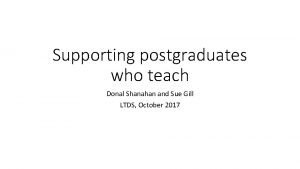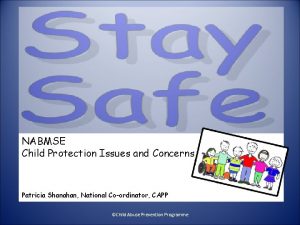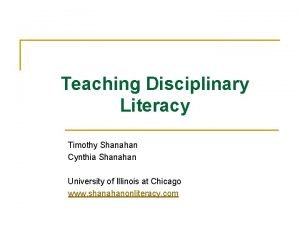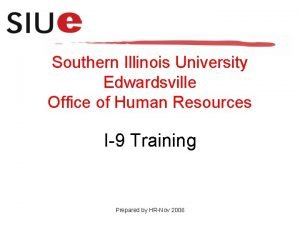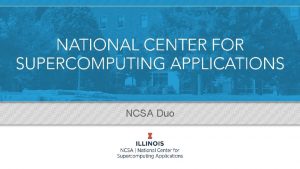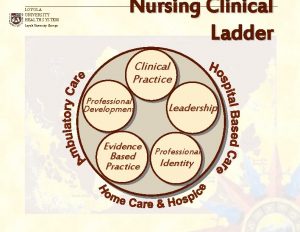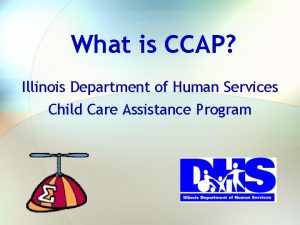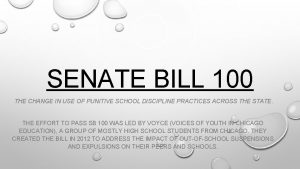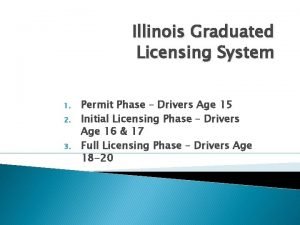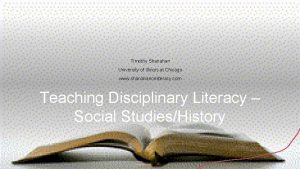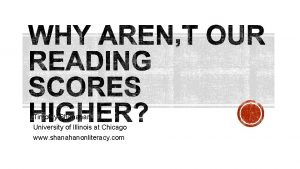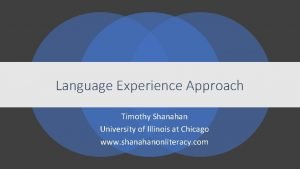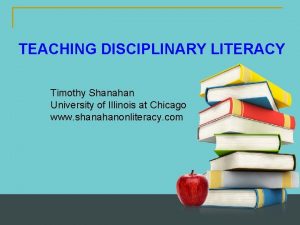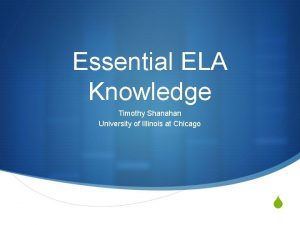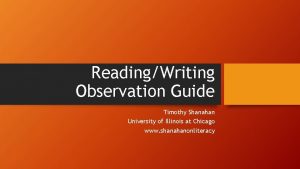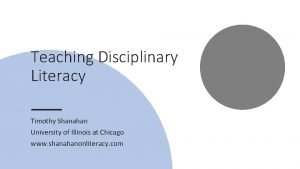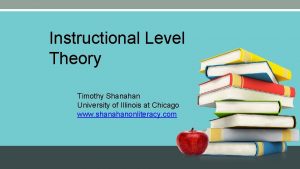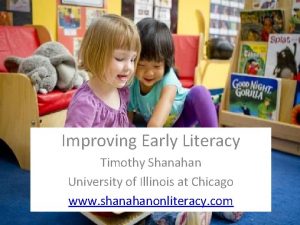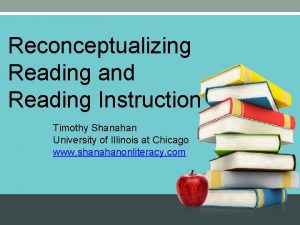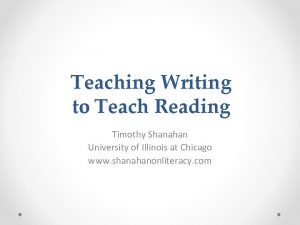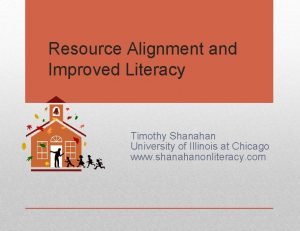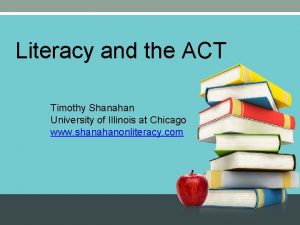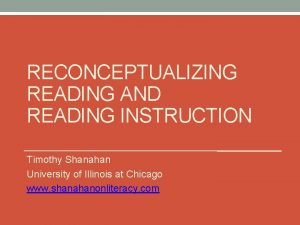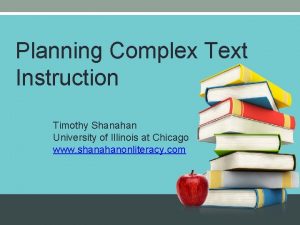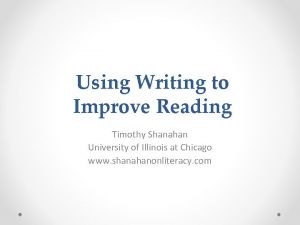Timothy Shanahan University of Illinois at Chicago www































- Slides: 31

Timothy Shanahan University of Illinois at Chicago www. shanahanonliteracy. com

§ According to the National Assessment of Educational Progress, the Nation’s Report Card, 37% of fourth-graders can read proficiently and 36% of eighth-graders § Michigan does as well as the U. S. at Grade 8, but significantly underperforms in Grade 4 § Reading scores have not risen since 2005 for fourth-graders nationwide, and eighth- graders have see-sawed a bit during that period, but the picture is similar for Michigan, too

§ The Program for International Student Achievement (PISA) reports that U. S. 15 -year- olds ranks behind those of 15 other countries § They underperform the kids in Canada, Finland, Ireland, Korea, Japan, Norway, New Zealand, Germany, Poland, etc.

§ Reading Excellence Act (1998)--$520 million to encourage reading instruction reform (K-5) § Reading First (2000)-–$5 billion to encourage research-based reading instruction (K-3) § Early Reading First (2001)– $680 million to encourage reading instruction reform in the primary grades § Striving Readers (2006)-- ~$250 million to encourage reading instruction reform in upper grades § LEARN (2015)-- $190 million to encourage reading improvement in Preschool-Grade 12 § And, don’t forget Title I, IDEA, or Head Start and the dozens of state initiatives

§ Parents? § Let’s face it, many parents aren’t pulling their fair share of the load § 30% of kids aren’t “school ready” when they come to school (Brookings, 2012) § Yep, if we could get parents to send better kids to school, our test scores would be higher

§ Screen time? § Kids 8 -18 are estimated to spend 7+ hours in front of screens each day § Those who spend more than 2 hours per day tend not to do as well at school as kids who watch less § Yep, it’s the screen time—if we didn’t have so many computers, pads, phones, etc. , are kids would do great-–let’s pitch technology

§ Immigration? § About 8 -9% of Michigan kids (higher in the U. S. ) are limited English learners § Kids who can’t speak English don’t do as well in American schools as native English speakers § Yep, our low scores definitely can be blamed on immigrants (build the wall and we’ll be great again)

§ Poverty? § Correlations between test performance and family income are high. § Childhood poverty can affect the brain—making it less able to learn (Noble, 2017) § SES includes income and parents’ education (those less likely to read and to read well are less likely to raise children who thrive in school) § Poverty also contributes to poor nutrition, school-interrupting illnesses, and stress § No question that if the government redistributed incomes and we all had the same opportunity our kids would read better

§ You and me? § Hey, wait a minute… what about parents, screen time, immigration, poverty? § One of the things that makes those other explanations so attractive to educators is that they place the responsibility on everyone else § Although it is true that all of those things do affect how teachable kids are, they are also beside the point if we are trying to figure out what we as educators should do § For example, at least some other countries manage to deliver more effective education to their poor kids (Darling-Hammond, 2014)—and the same is true of linguistic differences

§ Our kids may not be doing much better than in 2005, but they are outperforming where we were in 1992 (two bursts of improvement—one in the 1990 s and another 2001 -2005) § We need to keep reading instruction a priority § And we need to take responsibility for our portion of the issue

§ We don’t spend enough time on what makes a difference in making kids proficient § Most American elementary schools these days pride themselves on their 90 -minute reading blocks… but much of that time is devoted to things that do little to promote reading ability: reading to kids, independent reading time, shut-up sheets, kids keeping busy while teachers work with other kids § We’ve given high status to small group work and independent reading in our classrooms over those activities that have been found to improve reading achievement

§ Instead of a 90 -minute reading block, we should commit to providing 90 minutes of teaching and guided practice to each child each day § That might take more than 90 minutes to accomplish, but it would give kids a better chance of becoming proficient. § The 90 -minute block is often a myth anyway; watch closely and you’ll see that reading lessons don’t actually begin at the beginning of the school day and yet those school opening minutes are counted as literacy block time § 90 -minutes is particularly foolish in the primary grades—where it does nothing to increase the amount of literacy teaching

§ In my schools, I required 120 -180 minutes per day of reading and writing instruction. § It doesn’t need to be the same for all schools § It is a lot of time, but it is accomplishable if you get rid of things like test prep and extended specific skills teaching in comprehension (and other things that don’t make students better readers)

§ Research has identified a limited number of skills and abilities that if taught improve children’s reading achievement § Instruction should emphasize the development of these beneficial skills and abilities rather than ones that are just hypotheses (things that might raise reading achievement, but have not yet been proven) or personal goals

These essential skills and abilities are supported by substantial amounts of research indicating that we can teach these, children can improve in these, and improving these has an overall impact on their reading achievement § Decoding (phonemic awareness, letter names, phonics) § Oral reading fluency (accuracy, rate, expression) § Reading comprehension (strategies, written language including vocabulary, sentence combining, cohesion, text structure) § Writing (including spelling)

§ Lots of times teachers indicated that they teach these things, but time analysis suggests that they might not spend much time on particular ones § In Chicago, I required that teachers spend one-quarter of the instructional time on word knowledge (teaching both decoding and vocabulary, with instruction shifting from one to the other by grade 3) § I also required another 30 -45 minutes per day of oral reading fluency instruction § A similar time expenditure for reading comprehension § And writing, too

§ Too many American teachers believe kids would be better off reading on their own than working with a teacher because “reading is learned by reading” § No question that kids who read more, read better § But that doesn’t mean that all reading practice is equal § Kids can learn when reading on their own, but they learn more when working with others on their reading

§ Reading with a teacher is more powerful because the teacher—in the best of circumstances—is getting the students to read texts that provide opportunities to learn (e. g. , content, language, skills). § Reading with a teacher leads to more learning because of the accountability factor— teachers can make sure the kids make sense of the text (and learn to surmount the hurdles that may have blocked understanding) § Reading with a teacher leads to more learning because teachers can require rereading, deep discussions, writing about text, and so on

§ I would argue that about 50% of the ELA instructional time should be spent actually reading and writing § That would mean that kids would spend substantial amounts of time in decoding lessons on sounding out words, spelling words, sorting words on the basis of spelling pattern or pronunciation, and similar activities § They would spend about half of the fluency time reading challenging texts aloud and rereading them to improve how well they can read them § They would spend at least half of the comprehension time reading and rereading texts that they are trying to make sense of § They would spend at least half of the writing periods in writing (not just talking about it)

§ And there would be substantial opportunities to read and write within their other subjects as well—throughout the day and throughout the school year § In addition, kids should be encouraged and supported in finding a place for reading in their own lives – not in the teachers’ lives, not instead of their schoolwork

§ Students spend too much time being taught to read with books they can already read reasonably well § Despite the claims of some educators and marketers, there is no such thing as an instructional level in reading (at least beyond the very beginnings of reading) § Teaching kids at their supposed “reading levels” hasn’t been found to facilitate learning, but it does lower the sophistication and complexity of the content and language kids are working with

§ If a child is taught reading in third grade with second-grade books, when will he/she be taught with third-grade books? § Often children are tested on grade level passages, but they have had few opportunities to read such passages in their classrooms and no instruction in how to make sense of such text § Instead of viewing differentiation as a process of teaching different kids to read with different leveled books, we would get our kids to higher levels of reading achievement by varying the amount and type of scaffolding and support that we provide with grade level texts

§ Reading is not the ability to answer certain kinds of questions (typical comprehension skills instruction and test prep), but the ability to make sense of what a text says and means § Readers make sense of texts by taking advantages of the affordances provided by authors and by surmounting the barriers that they pose § Reading instruction should focus on teaching kids to read challenging texts—dealing with the vocabulary, grammar, cohesion, structure, content, and other affordances/barriers inherent in text rather than on practicing answering particular kinds of questions (e. g. , QAR, Bloom’s taxonomy, CCSS standards)

§ I suspect that most teachers do little to support or extend students’ reading stamina. § Oh, I know that many assign extended silent reading or pride themselves on having kids read books rather than excerpts (but those are usually sink-or-swim propositions —including little teaching or support) § What appears to predominate in American classrooms is guiding kids through texts round robin-style or having kids read short sections of text interspersed with discussion or teacher explanation

§ Kids would be better prepared for tests (and most real reading situations) if there was an intentional regimen of stretching how long they can persist in making sense of texts § For many students, the first time that they read an extended grade-level text silently is when they take their state’s third grade test § That kind ofreading should be taking place in classrooms, too, but with appropriate teaching support

§ Of course, Kindergarteners and first-graders are going to read aloud § But by second-grade kids should be doing a substantial amount of silent reading (perhaps with mumble or whisper reading as a bridge) § Texts should be segmented, initially, so that kids are not required to hold too much in memory § This segmenting could be as little as a single sentence—and then two and three, etc. § The idea is to intentionally stretch kids out, getting them to read longer and longer segments of text that they can retell or answer questions about § By the time kids are finishing third-grade, reading a 600+-word text silently with good comprehension should be the norm

§ Lack of a knowledge-focused curriculum is an important culprit, too § Reading comprehension depends upon the knowledge that readers bring to a text (that’s where the inferences and disambiguation come from) § Science and social studies aren’t given enough time in elementary school (we claim there is no time for these because of the requirements to teach the tested subjects, but there is sufficient time to include them) § We need to provide daily teaching in these other subject areas (math, social studies, science, the arts) § And those lessons should include the reading of rich content text

§ Texts about the social world and the natural worlds should be able to find a place within the reading instruction, too (along with fine literature) § I know that most reading programs do that kind of thing these days, but I’d go further if we want kids to test better we need to build student knowledge § I’m a big fan of including content learning objectives in reading programs (in other words, we should not just be interested in whether kids have accomplished the skills or vocabulary learning, but are they remembering the content of what they are reading? )

§ All of these points have focused on what it is that teachers can do to improve achievement § If teachers were to do this on scale, you’d see markedly higher reading achievement for American students § But my comments should not be perceived as taking Educational Policymakers off the hook

§ Policymakers and school leaders need to provide policies and resources that ensure that teachers receive sufficient high quality professional development and support § That they have adequate curriculum and instructional materials § That they have sufficient time to teach and to plan for that teaching § That parents and communities are included in these efforts § Everything I have described is doable, but most of those things are not being done because of inadequate school leadership, weak teacher education, flimsy non-existent curricula, and/or poorly informed parents

§ Ensure that kids are actually receiving substantial amounts of literacy instruction § Ensure that kids receive substantial instruction in decoding (PA, ABCs, phonics), fluency, vocabulary, reading comprehension, and writing § Encourage the kinds of reading practice that make kids better readers (coached reading, not independent reading) § Teach kids to read grade-level texts in grades 2 -12 § Build stamina and independence intentionally § Increase student knowledge of the natural and social worlds § Prepare and support teachers to do these things
 Timothy shanahan close reading
Timothy shanahan close reading Chicago, illinois (latitude 42°n) is located in the
Chicago, illinois (latitude 42°n) is located in the Donal shanahan
Donal shanahan Walter e smithe brothers
Walter e smithe brothers Patricia shanahan
Patricia shanahan Cynthia shanahan
Cynthia shanahan Southern illinois university human resources
Southern illinois university human resources University of illinois duo mobile
University of illinois duo mobile Student accounts ilstu
Student accounts ilstu Net math uiuc
Net math uiuc Globus alliance
Globus alliance Loyola chicago nursing
Loyola chicago nursing Cougar connect csu
Cougar connect csu Uchicago globus
Uchicago globus 詹景裕
詹景裕 Illinois ccap
Illinois ccap Pcg claiming system illinois
Pcg claiming system illinois Senate bill 100 illinois
Senate bill 100 illinois Polst illinois form
Polst illinois form Holocaust acrostic poem
Holocaust acrostic poem Oig rule 50
Oig rule 50 Northern illinois hockey league
Northern illinois hockey league Trp illinois
Trp illinois Escobedo v illinois
Escobedo v illinois Link up illinois
Link up illinois Sexually dangerous persons act illinois
Sexually dangerous persons act illinois Health care services lien act
Health care services lien act Explain the permit phase.
Explain the permit phase. Obra screening illinois
Obra screening illinois Illinois crop improvement association
Illinois crop improvement association Ibla illinois lacrosse
Ibla illinois lacrosse Illinois digital preservation
Illinois digital preservation


